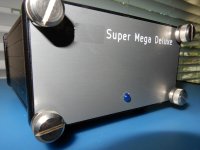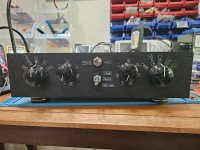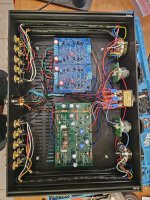Another option, though epoxy would make it a quick and painless procedure.
Doing the 2 closest to the faceplate first and then the back ones, easy peasy.
Doing the 2 closest to the faceplate first and then the back ones, easy peasy.
Or use Blu Tack?I'm thinking it would be feasible to super glue the nuts inside the rails so removing the top would just involve removing screws. It would need to be done most carefully, probably 1 nut at a time. One trick for leaving a screw in a nut when using superglue is a little beeswax, or the like on the screw threads.
Matter of fact you could probably get away with just the one screw where the metal has been bared, or a second for good luck.
Contact resistance should not change, hmm might throw something together quick and see how it behaves, I'm pretty keen on the toogle idea, the chassis is thick cast aluminium no vent holes, inside no ac other than signal
I would suggest something that hardens, locking the nuts in place permanently.Or use Blu Tack?
Depends on the switch quality.
Vent holes still something you are concerned with?
Do distortion/spectral analysis of each approach if you can, and report results with your toggle switch selection. 🙂
Vent holes still something you are concerned with?
Do distortion/spectral analysis of each approach if you can, and report results with your toggle switch selection. 🙂
Step 1 complete, top plate with 2 front nuts is lightly tightened waiting for glue to set. I didn't have 2 part epoxy, but did have Gorilla Glue, which needs moisture and time to cure.
I had a similar idea for the XLRs on my BA2018 preamp. I was thinking silicone or hot melt glue though...I'm thinking it would be feasible to super glue the nuts inside
Maybe there are clips?
No it's not a hammond, it's my old prema 5000 multimeter chassis, the dac chip died and are unobtainable, figured the chassis might be handy.
Ps photo is not mine , mine is yellow, so a paint job is needed.
Front and rear are standard 3mm aluminium rectangular that sits in slides, couldn't be easier

Ps photo is not mine , mine is yellow, so a paint job is needed.
Front and rear are standard 3mm aluminium rectangular that sits in slides, couldn't be easier
@GKTAUDIO
As much as I, too, like audio "jewelry" the problem with enclosures that clamour to be seen is that they might insist on a place in a less-than-optimal position in the "display". These nice cases for the Pearl 3 are a case in point (pardon the pun). Those companion units look lovely stacked together don't they!
In truth the only component that needs access and visibility alongside of the other hands-on components -- turntable CD player etc. -- is the pre-amp... volume, selector... and there are remotes eh.
A phono stage might be the opposite of our children -- should be heard but not seen.
It was with that in mind that the idea of the tubular cookie tin suggested itself to me. (this idea might be supplanted by an extruded aluminum section). The guts would be organized on either side of a central divider attached to the lid. Just open the tin to get at the DIP switches... very occasionally. The tin could be tucked wherever it worked best... out of sight (or not) and not out of mind... because of the great sound.
If I go the extrusion route I like the thumbscrews idea. Thanks!
As much as I, too, like audio "jewelry" the problem with enclosures that clamour to be seen is that they might insist on a place in a less-than-optimal position in the "display". These nice cases for the Pearl 3 are a case in point (pardon the pun). Those companion units look lovely stacked together don't they!
In truth the only component that needs access and visibility alongside of the other hands-on components -- turntable CD player etc. -- is the pre-amp... volume, selector... and there are remotes eh.
A phono stage might be the opposite of our children -- should be heard but not seen.
It was with that in mind that the idea of the tubular cookie tin suggested itself to me. (this idea might be supplanted by an extruded aluminum section). The guts would be organized on either side of a central divider attached to the lid. Just open the tin to get at the DIP switches... very occasionally. The tin could be tucked wherever it worked best... out of sight (or not) and not out of mind... because of the great sound.
If I go the extrusion route I like the thumbscrews idea. Thanks!
Last edited:
Initial cure of the front 2 screws is beauty, needs to fully set overnight. The 2nd set of screws are in place and curing. It wasn't quite easy peasy as lining the nuts up with the slots in the rails  Its all good in the end.
Its all good in the end.
 Its all good in the end.
Its all good in the end.Heh. Yes. That's why mine has a small, nondescript PS chassis box, sitting in a bundle of other power supplies. OTOH, I get great pleasure from seeing the RIAA box and associating the wonderful sound being transported through it. It's clean and subtle, and has cool blue lights.the problem with enclosures that clamour to be seen is that they might insist on a place in a less-than-optimal position
That said, it does have to sit a couple of feet away from the associated other gear. Doesn't bother me, as there are about 25 linear feet of audio equipment in the main room. It's obscene.
I just stick something in hole, tilt chassis until nut slides down to hole, put in screw, go to next one. Or, if top off, use same thing you poked in sc rew hole to slide nuts where they need to be, put top on and screws in.Or use Blu Tack?
My original audio goal for this summer was to build a 2-PSU version of the preamp design I have been developing that is based on Wayne's linestage. After completing the dual PSU Pearl 3, we joked earlier in this thread about “turtles all down the line” – meaning, you could design your entire left and right channels to be completely independent of each other with their own discrete PSU for each stage – the phonopre, the linestage, and the monoblock amp.
Have just finished this for my complete system and want to share some info.
Just done today is the preamp – see the attachments. This has been developing in order to allow me to connect and control all of the amps and media sources I use. Here are some characteristics:
The device is copper wired from point to point and has no noise (outside of the Korg Tube pre).
It can operate in passive or active modes.
Active modes select either tube or SS preamplification.
Five in and 5 out allows for rapid switching to any of 5 amp types (a listening technique I term active amp listening).
Was just able today to finish this 2-PSU pre and, now, have the entire system with discrete right and left channels.
The difference is significant.
Will just summarize a few thoughts here and if there is any interest will provide additional data. The system chain is as follows:
VPI Prime Turntable with Blue Quintet cart (soon to be a Hana ML)
Pearl 3 PhonoPre with Dual PSU
Custom Preamp (just described) with Dual PSU
Aleph 30 Monoblock Amps (Thatcher clone)
Immediately upon initial turn on I was shocked by one quality: turntable vinyl noise was significantly lower. Just as this started with the P3, the difference between music and noise has become even greater and you hardly notice average vinyl noise on 1970s albums at all.
Secondly, the voices and instruments are so accurate timbrally that they sound completely natural and solidly secure. This sense of naturalism is especially evident with pianos, notably concert instruments.
Third, there is much more “musical space” in front of you with each voice/section,soloist tightly defined and plenty of space (=air) between them. Just as with timbre, the sense of naturalism extends to placement within the soundstage.
Fourth, crescendos are comfortable and controlled with very pleasant fff passages that are easy on the ear even though very loud. And this characteristic is throughout – music played at loud levels doesn't sound forced or “loud.” It sounds big and inviting.
Have more thoughts but these are just a few obvious ones after two initial listening sessions.
So for this musician, it's “turtles all the way down.” Have never enjoyed vinyl this much. Those demanding classical albums shine like they never have before. If you want to test your system, there's nothing like a full orchestra recorded, mastered, and produced in analog. That will show off this “Turtles” approach to the fullest.
And, BTW, as I have been stressing to those who have requested Dual PSU info, how much of this improvement is audible to you will depend on your system. Bad speakers, bad room, lousy vinyl – you will not hear much improvement.
When you reach the very good component level, then the Turtles approach has merit. If you hear such a Turtles system, watch out! You're not going to want anything else...
Have just finished this for my complete system and want to share some info.
Just done today is the preamp – see the attachments. This has been developing in order to allow me to connect and control all of the amps and media sources I use. Here are some characteristics:
The device is copper wired from point to point and has no noise (outside of the Korg Tube pre).
It can operate in passive or active modes.
Active modes select either tube or SS preamplification.
Five in and 5 out allows for rapid switching to any of 5 amp types (a listening technique I term active amp listening).
Was just able today to finish this 2-PSU pre and, now, have the entire system with discrete right and left channels.
The difference is significant.
Will just summarize a few thoughts here and if there is any interest will provide additional data. The system chain is as follows:
VPI Prime Turntable with Blue Quintet cart (soon to be a Hana ML)
Pearl 3 PhonoPre with Dual PSU
Custom Preamp (just described) with Dual PSU
Aleph 30 Monoblock Amps (Thatcher clone)
Immediately upon initial turn on I was shocked by one quality: turntable vinyl noise was significantly lower. Just as this started with the P3, the difference between music and noise has become even greater and you hardly notice average vinyl noise on 1970s albums at all.
Secondly, the voices and instruments are so accurate timbrally that they sound completely natural and solidly secure. This sense of naturalism is especially evident with pianos, notably concert instruments.
Third, there is much more “musical space” in front of you with each voice/section,soloist tightly defined and plenty of space (=air) between them. Just as with timbre, the sense of naturalism extends to placement within the soundstage.
Fourth, crescendos are comfortable and controlled with very pleasant fff passages that are easy on the ear even though very loud. And this characteristic is throughout – music played at loud levels doesn't sound forced or “loud.” It sounds big and inviting.
Have more thoughts but these are just a few obvious ones after two initial listening sessions.
So for this musician, it's “turtles all the way down.” Have never enjoyed vinyl this much. Those demanding classical albums shine like they never have before. If you want to test your system, there's nothing like a full orchestra recorded, mastered, and produced in analog. That will show off this “Turtles” approach to the fullest.
And, BTW, as I have been stressing to those who have requested Dual PSU info, how much of this improvement is audible to you will depend on your system. Bad speakers, bad room, lousy vinyl – you will not hear much improvement.
When you reach the very good component level, then the Turtles approach has merit. If you hear such a Turtles system, watch out! You're not going to want anything else...
Attachments
Last edited:
@Craigl59
wait... what???
you were making a joke about "turtles"???
hey buddy, "turtles all the way down" is a cherished precept of cosmology. this is serious stuff. (ouch... my tongue got stuck in my cheek)
very nice work. compelling approach.
(by the way have you read "three scientists and their gods", particularly the section on Friedkin? Fun stuff)
wait... what???
you were making a joke about "turtles"???
hey buddy, "turtles all the way down" is a cherished precept of cosmology. this is serious stuff. (ouch... my tongue got stuck in my cheek)
very nice work. compelling approach.
(by the way have you read "three scientists and their gods", particularly the section on Friedkin? Fun stuff)
- Home
- Amplifiers
- Pass Labs
- Pearl 3 Burning Amp 2023



